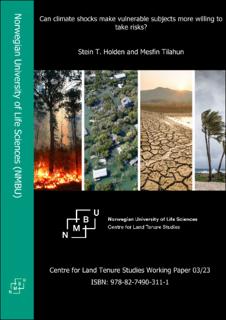| dc.contributor.author | Holden, Stein T. | |
| dc.contributor.author | Tilahun, Mesfin | |
| dc.coverage.spatial | Ethiopia | en_US |
| dc.date.accessioned | 2023-01-28T06:23:03Z | |
| dc.date.available | 2023-01-28T06:23:03Z | |
| dc.date.issued | 2023-01 | |
| dc.identifier.isbn | 978-82-7490-311-1 | |
| dc.identifier.uri | https://hdl.handle.net/11250/3046945 | |
| dc.description.abstract | While economists in the past tended to assume that individual preferences, including risk preferences, are stable over time, a recent literature has developed and indicates that risk preferences respond to shocks. This paper utilizes a natural experiment with covariate (drought) and idiosyncratic shocks in combination with an independent field risk experiment. The risk experiment uses a Certainty Equivalent - Multiple Choice List (CE-MCL) approach and is played 1-2 years after the subjects were (to a varying degree) exposed to a covariate drought shock or idiosyncratic shocks. The experimental approach facilitated a comprehensive assessment of shock effects on experimental risk premiums with varying probabilities of good and bad outcomes. The experiment also facilitates the estimation of the utility curvature in an Expected Utility (EU) model, and alternatively, separate estimation of probability weighting and utility curvature in three different Rank Dependent Utility (RDU) models with a two-parameter Prelec probability weighting function. Our study is the first to comprehensively test the theoretical predictions of Gollin and Pratt (1996) versus Quiggin (2003). Gollin and Pratt (1996) build on EU theory and state that an increase in background risk will make subjects more risk averse while Quiggin (2003) states that an increase in background risk can enhance risk-taking in certain types of non-EU models. We find strong evidence that such non-EU preferences dominate in our sample and can explain the surprising result. In our sample of resource-poor young adults living in a risky semiarid rural environment in Sub-Saharan Africa, we find that the covariate drought shock had negative effects on risk premiums and the utility curvature and caused an upward shift in the probability weighting function. To our knowledge, this is the first paper to carry out such a rigorous test of a shock effect on utility curvature and probability weighting. | en_US |
| dc.language.iso | eng | en_US |
| dc.publisher | Norwegian University of Life Sciences, Ås | en_US |
| dc.relation.ispartofseries | CLTS Working paper;03/23 | |
| dc.rights | Attribution-NonCommercial-NoDerivatives 4.0 Internasjonal | * |
| dc.rights.uri | http://creativecommons.org/licenses/by-nc-nd/4.0/deed.no | * |
| dc.subject | Covariate shocks | en_US |
| dc.subject | Idiosyncratic shocks | en_US |
| dc.subject | Stability of risk preference parameters | en_US |
| dc.subject | Field experiment | en_US |
| dc.subject | Ethiopia | en_US |
| dc.title | Can climate shocks make vulnerable subjects more willing to take risks? | en_US |
| dc.type | Working paper | en_US |

